Advanced Volleyball Practice Drills - Offensive Volleyball Drills with Coverage
We introduce few ideas how to organize volleyball
practice drills about offense and coverage.
This drill is one
of the most
exciting volleyball drill for the team since it focuses on building
teamwork.
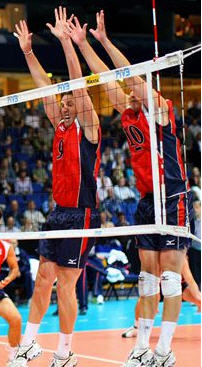
These volleyball drills are more advanced drills. Therefore we have given them a four star rating out of five. Meaning the players need to have a high skill level in order to execute drills successfully.
These drills are more difficult, but when running them you notice how excited players get about teamwork and helping each other on the court.
Learning to Adjust the Volleyball Practice Drills
As we mentioned in advanced volleyball drills opening page; if
the players struggle with the drills, the coach should be prepared to
ease up the drill. The coach is able to modify these drills to fit any team’s skill level very easily.
Volleyball Practice Drills Examples - Offensive Volleyball Drills with Coverage
What is the purpose of these volleyball practice drills?- To learn the coverage techniques,
- For hitters to learn one more offensive strategy, which is "hitting the ball into the block and covering it up"
- To learn communication and teamwork.
Building Teamwork and Communication
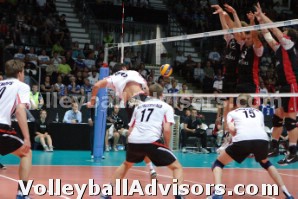 The drill may not be an exact match to
the game, but it
is an excellent drill to improve communication and teamwork.
The drill may not be an exact match to
the game, but it
is an excellent drill to improve communication and teamwork.As its simplicity this drill is executed by swinging the ball to the block to cover it up.
If you don’t fully understand why hitting to the block would make sense, click the fun volleyball drills link in the bottom of this page. Through the link you get more information about this commonly used strategy for the skilled hitters.
How to Run Those Volleyball Coverage Drills?
Version I - "Fun Offensive/Coverage Game (4 stars)
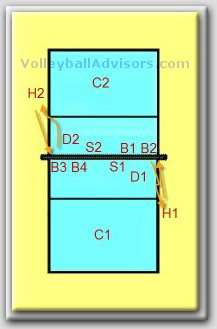 The
Hitter (H1 and H2)
The
Hitter (H1 and H2)This drill could be run either on zone 4 (outside hitter, wing hitter) or zones 2 or 1 (right side hitter or 10 feet right side).
In the picture it is run on the right side (zone 2) - on the both sides of the net.
H1 and H2 are two right side hitters who keep on approaching and hitting to the block one after another. The hitter will be busy!!
Remember to switch the hitter often. The offensive player gets exhausted due to fast tempo.
It will be a little bit easier for the hitter when running this drill on the left side. The hitter has more time to approach since the setter is further away.
Coach (C1 and C2) and Setter (S1 and S2)
Coaches or other players (C1 and C2) start the rally by tossing the ball to the setter (S1 or S2), who sets to the right side hitter (H1 or H2).
Defensive Player (D1 and D2)
A setter, hitter and 1-2 players for the coverage is needed on both sides. In the picture there is one defensive player on each side (D1 and D2). D1 and D2 keep covering the ball up, which is hit to the block by H1 and H2.
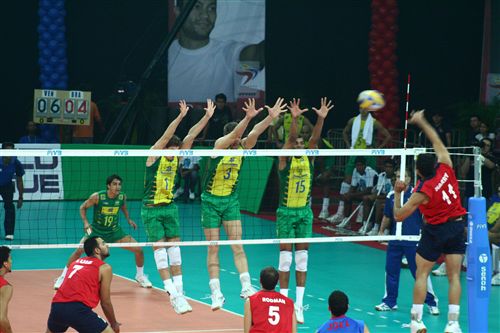 Make sure the
player covers the ball high to give the setter enough time to set the
next ball and the hitter enough time to approach again.
Make sure the
player covers the ball high to give the setter enough time to set the
next ball and the hitter enough time to approach again.Important! In the match the setter covers also. If the setter covers the ball up the defender has to act as a setter.
Blocker (B1, B2 and B3, B4)
The coach could use some blocking equipment to block the hitter. That forces the attacker to hit the ball to the block, which supposed to be done in this drill.
Or alternatively the coach could put 2-3 players higher on the stand to block the hitter. In the picture there are two blockers on the both sides of the net on the stand (B1, B2 and B3, B4).
 Blockers on
the stand do not jump, they just reach and penetrate over the net after
the ball is released from the setter.
Blockers on
the stand do not jump, they just reach and penetrate over the net after
the ball is released from the setter. We prefer the real block, instead of blocking equipment, if there are enough players to make it happen. Their job is to form a steady block to direct the ball straight down to the players on the coverage.
Notice!
The next progression below is more game-like. Run this first stage, if you want to test your players ball control skills - and want them to run a fun game while working on communication and teamwork.
Volleyball
Practice Drills for Coverage - Tips to Run the Drill Smoothly
How to Ease Up the Drill?In case this drill is not running smoothly, the coach could make it easier i.e. by stopping the rally and feeding the new ball for the setter after the ball is covered.
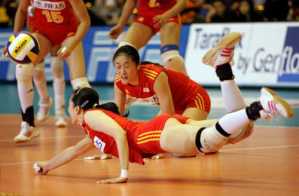
Ball Control Important! Expectional ball control is needed.
The drill may not be suitable for inexperienced players, since it requires a great ball control and good communication between the players.
No Jumping on the Block
Suggestion: DO NOT allow players to jump when blocking, since the block is not stopping the ball often enough. It will mess up the purpose of this drill, which is to practice covering on every single attack.
Change the Hitter Often
Don’t let the hitter get too exhausted, 5-8 swings combined with approaches are enough to get him/her tired. The hitter should be changed often.
This drill is easier for the hitter when running it on the left side.
Give time - Cover the ball high
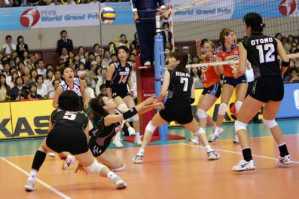
It may get really "crowded" on the right side under the block after the coverage ball is passed up.
How to avoid it?
The players on the coverage needs to pass the ball high enough, maybe a little bit off the net and away from the regular setting position.
If the drill is executed on the left side, or by the setter dishing sets both left and right side hitter, it makes the drill less "crowded".
Volleyball Practice Drills - Max out the Reps
Activate all the Players - Don't Make Them Wait for Their Turn in Practice
As in any other volleyball drill, try to activate all the players by organizing the same drill on the both sides of the net.
If the drills is run on the both court sides, there will not be too much room since the setter is located next to the blockers on the stand, but it will work out fine with a little adjustments. Whenever possible use more than one court.
Max the Reps by Small Groups
To maximize the repetitions of the players, you should have only max 3-4 players (setter, hitter, max 1-2 players to cover) in each group.
Volleyball Practice Drills for Teamwork and Coverage - Variations
The hitter on the left side.Important! If running this drill on the left side on the both sides of the net, the ball needs to be covered off the net - since blockers from the other side are on the setter's spot.
Back Row Hitter
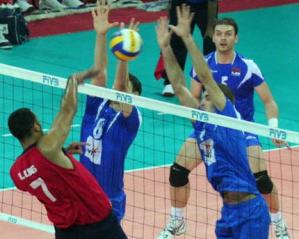 Run the drill on the right
side when the hitter
swings from the back row.
Run the drill on the right
side when the hitter
swings from the back row.Advanced Variation: Moving More Toward Game-like
If you want to run this drill more game-like, you should have the setter delivering the ball either to the left or right side.
The drawback is; it takes the whole court. Also the long distances between the players require even more ball control.
Volleyball Practice Drills - Game-like Version
Version II - Game-like - Offensive Volleyball Drills with Coverage (4 stars)
This variation could be a little bit harder than the first one.
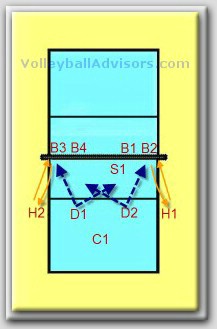
Setter (S1)
In this variation the setter has an opportunity to set the ball either side (outside hitter or right side hitter).
Blocker (B1, B2, B3, B4)
The coach needs more blockers on the stands. Two blockers are needed on both sides (B1, B2 and B3, B4).
If the players are skilled enough, the coach could use three blockers and perform the drill without stands. Blockers read the setter and set up two or three man block in front of the spiker.
Defensive Players in the Coverage (D1, D2, C1)
In the picture there are two players (D1 and D2) to cover the hitters on the same side. There could possibly be even one more player to cover (C1).
C1, D1, D2 as Passers or C1 as Ball Feeder
C1 feeds the ball for the setter. Or if the player's skills allow, C1, D1 and D2 could be passing the serve to the setter - before moving to cover the ball.
Defensive Court Side
Moreover, also defensive players could be put to the other side of the court. Then hitters H1 and H2 could be practicing scoring the ball or to play it back to the own side from the block - just like in the match.
Check Fun Volleyball Drills section for the information how these volleyball practice drills can be used to build a teamwork and unity.
Like this page:




